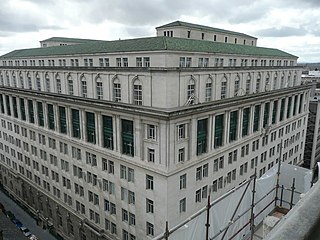
India Buildings is a commercial building with its principal entrance in Water Street, Liverpool, England. Mainly an office building, it also contains an internal shopping arcade and the entrance to an underground station. It was built between 1924 and 1932, damaged by a bomb in 1941, and later restored to its original condition under the supervision of one of its original architects. The building, its design influenced by the Italian Renaissance and incorporating features of the American Beaux-Arts style, occupies an entire block in the city.

Rundle Mall is a pedestrian street mall located in Adelaide, South Australia. It was opened as a pedestrian mall in September 1976 by closing the section of Rundle Street between King William Street and Pulteney Street, to vehicular traffic. The street continues as Rundle Street to the east and Hindley Street to the west.
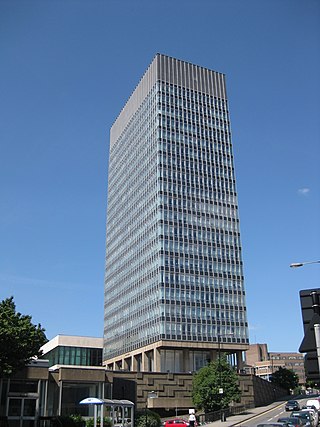
The Arts Tower is a building at 12 Bolsover Street in Sheffield, England, belonging to the University of Sheffield and which opened in 1965. A spokesperson for English Heritage described it as "the most elegant university tower block in Britain of its period". At 78 m (256 ft) tall, it is the second-tallest building in the city, after the 101 m (331 ft) St Paul's Tower on Arundel Gate, which was topped out in 2009. Mitchell Construction a British civil engineering firm, built the Arts Tower. Photographs from their topping out ceremony in October 1964 help to document a different era in UK working conditions.

The Queen Victoria Building is a heritage-listed late-nineteenth-century building located at 429–481 George Street in the Sydney central business district, in the state of New South Wales, Australia. Designed by the architect George McRae, the Romanesque Revival building was constructed between 1893 and 1898 and is 30 metres (98 ft) wide by 190 metres (620 ft) long. The domes were built by Ritchie Brothers, a steel and metal company that also built trains, trams and farm equipment. The building fills a city block bounded by George, Market, York, and Druitt Streets. Designed as a marketplace, it was used for a variety of other purposes, underwent remodelling, and suffered decay until its restoration and return to its original use in the late twentieth century. The property is co-owned by the City of Sydney and Link REIT, and was added to the New South Wales State Heritage Register on 5 March 2010.

Belfast Castle is a mansion located in Cave Hill Country Park in Belfast, Northern Ireland, in a prominent position 400 feet (120 m) above sea level. Its location provides unobstructed views over the City of Belfast and Belfast Lough. There have been several structures called "Belfast Castle" over the centuries, located on different sites. The current "castle" is a Victorian structure, built between 1867 and 1870 on the slopes of Cave Hill, and is Grade A listed. The main entrance into the Belfast Castle Demesne is now where Innisfayle Park meets Downview Park West, just off the Antrim Road. The original main entrance into the current demesne was formerly on the Antrim Road itself, where Strathmore Park now meets the Antrim Road.

The Treasury Building, previously known as the New Public Offices, is a heritage-listed former public administration building located at 21 Queen Street in Brisbane, Queensland, Australia. It was built from 1886 to 1928 for the Queensland Government. On 21 October 1992 the Italian Renaissance building was added to the Queensland Heritage Register.

Briggate is a pedestrianised principal shopping street in Leeds city centre, England. Historically it was the main street, leading north from Leeds Bridge, and housed markets, merchant's houses and other business premises. It contains many historic buildings, including the oldest in the city, and others from the 19th and early-20th century, including two theatres. It is noted for the yards between some older buildings with alleyways giving access and Victorian shopping arcades, which were restored in late 20th century. The street was pedestrianised in the late-20th century.

Capitol Centre is an indoor shopping centre in the city of Cardiff, Wales. Functioning as one of the city's retail malls, The building is built on the site of the former Capitol Theatre, and is situated at the eastern end of Queen Street near the Dumfries Place bus terminus and Cardiff Queen Street railway station.

The Cathedral Quarter in Belfast, Northern Ireland, is a developing area of the city, roughly situated between Royal Avenue near where the Belfast Central Library building is, and the Dunbar Link in the city centre. From one of its corners, the junction of Royal Avenue, Donegall Street and York Street, the Cathedral Quarter lies south and east. Part of the area, centred on Talbot Street behind the cathedral, was formerly called the Half Bap. The "Little Italy" area was on the opposite side of Great Patrick Street centred on Little Patrick Street and Nelson Street.
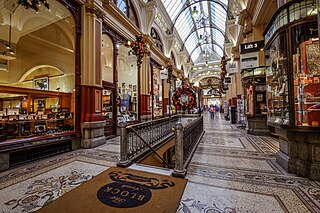
The Block Arcade is a historic shopping arcade in the central business district of Melbourne, Victoria, Australia. Constructed between 1891 and 1893, it is considered one of the late Victorian era's finest shopping arcades and ranks among Melbourne's most popular tourist attractions.

Victoria Square is a shopping complex located in Belfast, Northern Ireland. The area includes over 62 shops, 16 restaurants and an Odeon cinema. Opened on 6 March 2008, Victoria Square is a commercial, residential and leisure development that took 6 years to build. Its anchor tenant is the largest House of Fraser that the retailer has opened in the UK, at nearly 200,000 square feet (19,000 m2).
The Tribeca Belfast development, formerly known as North East Quarter and previously Royal Exchange, is a planned £500 million development based in the north east of Belfast City Centre. It is a major mixed-use regeneration scheme, with a total area of 1.5 million sq ft (0.14 million m2) as of 2018. The development has generated controversy since its inception in 2003. Over the years, opposition has been levelled against its lack of care towards existing important built heritage, lack of integration with local small businesses and arts organisations and even its brand name, and much of its existence so far has been in the context of an arson attack on one of the existing buildings in 2004, while under the ownership of the developers.
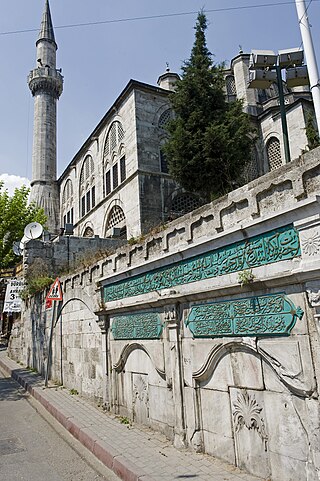
Mesih Mehmed Pasha Mosque is a 16th-century Ottoman mosque in the Fatih district of Istanbul. It was commissioned by one of Murad III's grand viziers, Mesih Mehmed Pasha, and designed by the imperial architect Mimar Sinan. The mosque was completed in 1585–86.
The architecture of Belfast comprises architectural styles ranging from Georgian through to modernist buildings such as the Waterfront Hall and Titanic Belfast. The city's Victorian and Edwardian buildings are notable for their display of a large number of sculptures. Many of Belfast's Victorian era landmarks, including the main Lanyon Building at Queens University, were designed by Sir Charles Lanyon.

The North Street Arcade is a 1930s Art Deco shopping arcade in the Cathedral Quarter of Belfast, Northern Ireland. It is the only example of a shopping arcade from this decade in Northern Ireland, and is one of only a handful left in the whole of Ireland or the UK. A Grade B1 listed building, it has been derelict since a fire in 2004.

Challis House is a heritage-listed commercial building located at 4–10 Martin Place in the Sydney central business district, in the City of Sydney local government area of New South Wales, Australia. The property was added to the New South Wales State Heritage Register on 2 April 1999.

Launceston Post Office is a heritage-listed post office at 68-72 Cameron Street, Launceston, Tasmania, Australia. It was designed by William Waters Eldridge, with alterations prior to opening designed by Corrie and North. It opened in 1891, while the clock tower was completed in 1903 and altered in 1910. It was added to the Australian Commonwealth Heritage List on 22 June 2004.

The Down Arts Centre, formerly Downpatrick Town Hall and also Downpatrick Assembly Rooms, is a municipal structure in Irish Street in Downpatrick, County Down, Northern Ireland. The structure, which was the meeting place of Down Urban District Council, is a Grade B1 listed building.
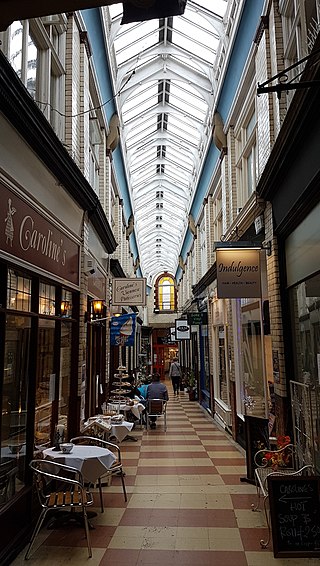
The Central Arcade, historically known as the Hope Street Arcade or Wrexham Arcade, is a shopping arcade in Wrexham city centre, Wales. Connecting Wrexham's Hope Street to the Butcher's Market, it was built in 1891.























